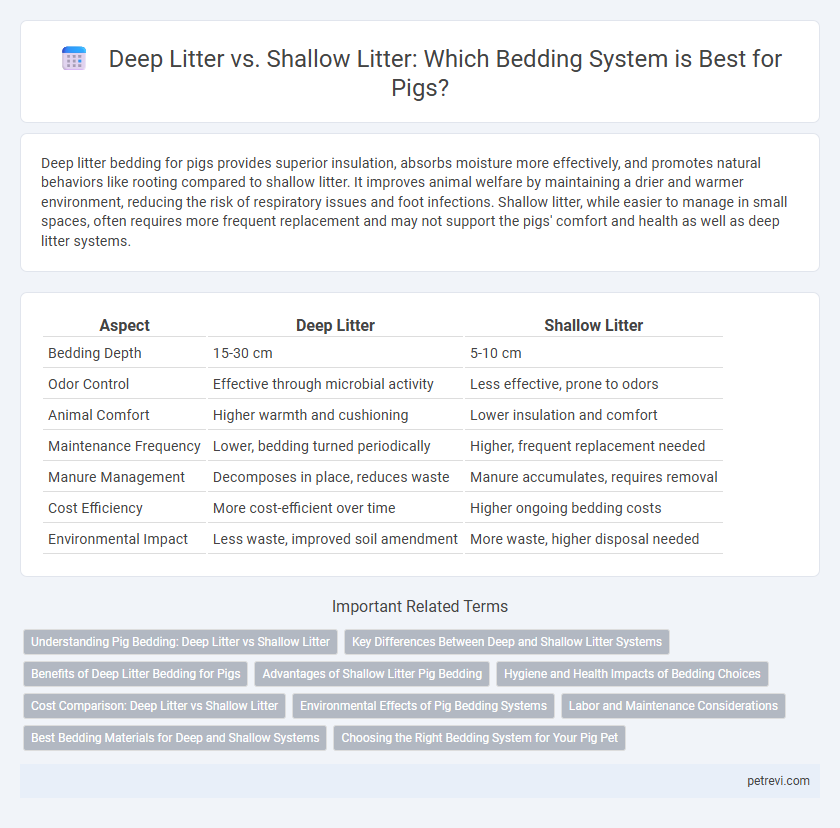Deep litter bedding for pigs provides superior insulation, absorbs moisture more effectively, and promotes natural behaviors like rooting compared to shallow litter. It improves animal welfare by maintaining a drier and warmer environment, reducing the risk of respiratory issues and foot infections. Shallow litter, while easier to manage in small spaces, often requires more frequent replacement and may not support the pigs' comfort and health as well as deep litter systems.
Table of Comparison
| Aspect | Deep Litter | Shallow Litter |
|---|---|---|
| Bedding Depth | 15-30 cm | 5-10 cm |
| Odor Control | Effective through microbial activity | Less effective, prone to odors |
| Animal Comfort | Higher warmth and cushioning | Lower insulation and comfort |
| Maintenance Frequency | Lower, bedding turned periodically | Higher, frequent replacement needed |
| Manure Management | Decomposes in place, reduces waste | Manure accumulates, requires removal |
| Cost Efficiency | More cost-efficient over time | Higher ongoing bedding costs |
| Environmental Impact | Less waste, improved soil amendment | More waste, higher disposal needed |
Understanding Pig Bedding: Deep Litter vs Shallow Litter
Deep litter bedding for pigs involves maintaining a thick, layered bed of organic material such as straw or wood shavings that undergoes controlled decomposition, providing warmth and improved waste absorption. Shallow litter uses a thin layer that is frequently cleaned and replaced, resulting in less microbial activity and reduced insulation. Choosing between deep and shallow litter impacts pig comfort, ammonia control, and manure management efficiency in swine production systems.
Key Differences Between Deep and Shallow Litter Systems
Deep litter systems for pig bedding use thick layers of organic material that decompose over time, generating heat and reducing ammonia emissions, while shallow litter systems involve thinner bedding that requires more frequent replacement and less microbial activity. Deep litter provides better insulation and enhanced comfort due to the ongoing fermentation process maintaining warmth, whereas shallow litter is easier to manage but offers less thermal regulation. The choice impacts waste management, odor control, and overall animal welfare in pig housing.
Benefits of Deep Litter Bedding for Pigs
Deep litter bedding for pigs enhances manure decomposition, leading to reduced ammonia emissions and improved air quality in pig housing. This method provides thermal insulation, maintaining a warmer environment that promotes pig comfort and health, especially in colder climates. Deep litter also supports beneficial microbial activity, which aids in nutrient recycling and reduces the need for frequent cleaning.
Advantages of Shallow Litter Pig Bedding
Shallow litter pig bedding offers improved hygiene by allowing easier waste removal and reducing ammonia buildup, promoting healthier respiratory conditions for pigs. It also requires less material, lowering bedding costs and labor associated with frequent replacement. Enhanced comfort and drier surfaces in shallow litter systems contribute to better hoof health and overall pig welfare.
Hygiene and Health Impacts of Bedding Choices
Deep litter bedding in pig farming promotes better hygiene by allowing natural microbial decomposition, reducing ammonia levels, and minimizing pathogen buildup compared to shallow litter. This method enhances pig health through improved air quality and lower respiratory disease risks, while shallow litter often leads to wetter, more compacted conditions that foster bacterial growth and parasites. Choosing deep litter supports a more sustainable environment by maintaining dry, aerated bedding that sustains pig welfare and reduces veterinary interventions.
Cost Comparison: Deep Litter vs Shallow Litter
Deep litter systems typically incur higher initial costs due to the requirement for more bedding material and labor for proper layering and maintenance. Shallow litter bedding is generally less expensive upfront but may lead to increased costs over time from more frequent cleaning and bedding replacement. Evaluating total expenses over the pig production cycle reveals deep litter can offer cost savings by improving manure management and reducing bedding waste.
Environmental Effects of Pig Bedding Systems
Deep litter systems in pig bedding significantly reduce ammonia emissions by promoting microbial activity that breaks down manure more effectively, enhancing air quality in pig housing. Shallow litter systems, conversely, require more frequent cleaning which can lead to increased manure runoff and higher nitrogen leaching into surrounding soil and water bodies. Sustainable pig farming benefits from deep litter approaches due to their superior environmental impact, including improved waste management and reduced greenhouse gas emissions.
Labor and Maintenance Considerations
Deep litter bedding in pig farming reduces labor by minimizing daily cleaning and bedding replacement, as the composting process decomposes waste over time. Shallow litter requires more frequent maintenance and manual removal, increasing labor intensity and time spent on sanitation. Choosing deep litter can lead to lower overall maintenance costs and improved labor efficiency in pig housing management.
Best Bedding Materials for Deep and Shallow Systems
Deep litter systems benefit from absorbent and compostable materials like wood shavings, straw, and rice hulls that promote microbial activity and moisture control. Shallow litter systems require finer, drier bedding such as chopped straw or sawdust to provide cushioning and maintain dryness. Optimal bedding choices enhance pig comfort, reduce ammonia buildup, and support waste breakdown in both deep and shallow litter setups.
Choosing the Right Bedding System for Your Pig Pet
Deep litter bedding provides enhanced insulation, odor control, and composting benefits by allowing manure and bedding to mix and break down over time, creating a healthier environment for pigs. Shallow litter requires frequent cleaning and replacement but can reduce moisture buildup and is easier to manage for smaller pig pens or indoor spaces. Selecting the right bedding depends on factors like pen size, climate, pig density, and maintenance resources to ensure optimal comfort and hygiene.
Deep litter vs Shallow litter for Pig bedding Infographic

 petrevi.com
petrevi.com